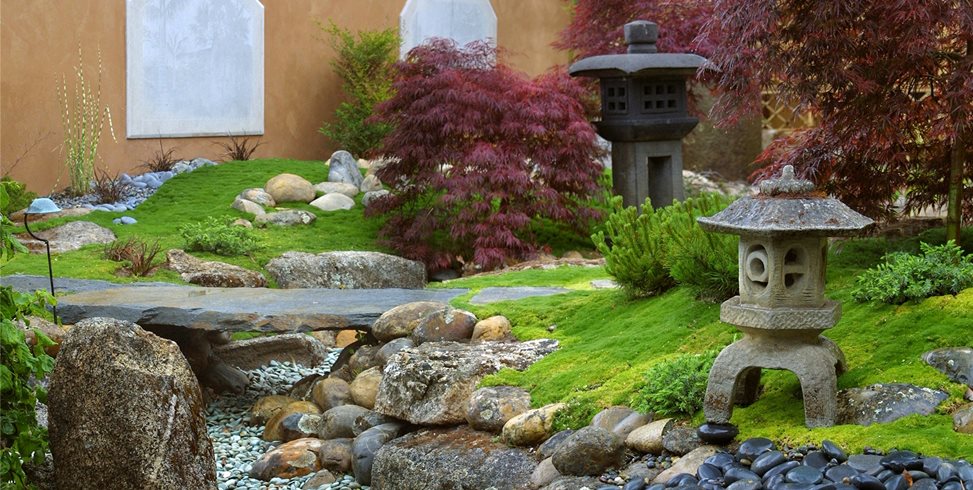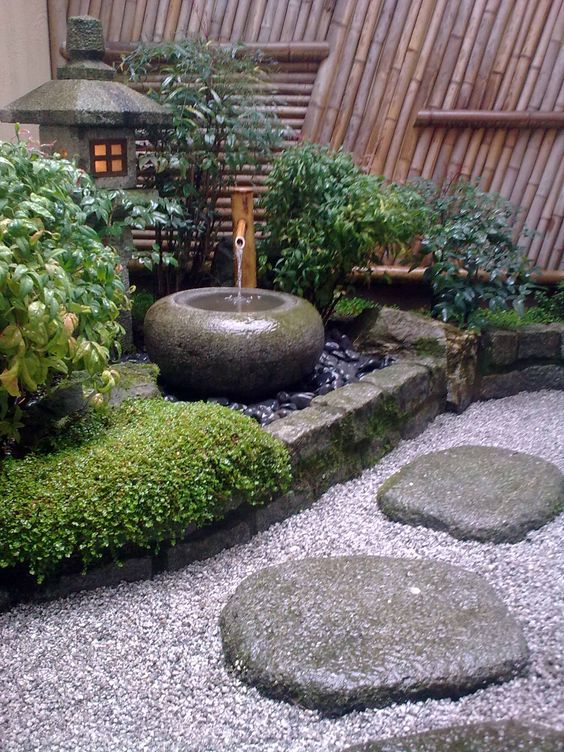Japanese patio design focuses on simplicity, natural elements, and harmonious layouts. It creates tranquil and aesthetically pleasing outdoor spaces.
Japanese patio design emphasizes minimalism, natural materials, and balance. These gardens often feature elements like water, rocks, and plants to create a serene atmosphere. Bamboo, stone lanterns, and wooden structures add to the authenticity. Patios are designed to be both functional and beautiful, encouraging relaxation and contemplation.
The careful arrangement of elements promotes a sense of peace and connection with nature. This design style is perfect for those seeking a calm and inviting outdoor space. By incorporating traditional Japanese principles, you can transform your patio into a serene retreat.
The Essence Of Japanese Patio Design
Japanese patio design captures the beauty of nature and simplicity. It transforms any outdoor space into a serene retreat. Emphasizing natural elements, minimalism, and tranquility, it creates harmony and balance. Let’s explore the key aspects of this unique design style.
Incorporating Natural Elements
In Japanese patios, natural elements play a critical role. Stones, water, and plants create a peaceful ambiance. A small pond or fountain can add a touch of tranquility. Moss-covered stones and bamboo create a natural look. Trees like maple and cherry blossom bring seasonal color changes.
Key Natural Elements:
- Stones and gravel
- Water features
- Plants and trees
- Bamboo and moss
Using these elements helps connect the patio with nature. It fosters a sense of calm and relaxation.
Minimalism And Simplicity
Japanese patio design values minimalism and simplicity. It avoids clutter and unnecessary items. Clean lines and open spaces dominate the design. Furniture is simple, often made of natural materials like wood or stone.
Key Features of Minimalism:
- Clutter-free spaces
- Simple, clean lines
- Natural materials
- Functional design
Minimalism helps create a peaceful and calming environment. It allows the mind to rest and rejuvenate.
By embracing these principles, your patio can become a sanctuary. It will offer a quiet escape from the hustle and bustle of daily life.

Credit: www.landscapingnetwork.com
Historical Roots Of Japanese Gardens
Japanese gardens have deep historical roots. They blend spirituality and nature. These gardens create serene spaces. The history of Japanese gardens is rich. It includes influences from Zen Buddhism and ancient Shinto practices.
Zen Buddhism Influence
Zen Buddhism greatly influenced Japanese garden design. It values simplicity and tranquility. Japanese rock gardens, or karesansui, are notable examples. These gardens feature rocks, gravel, and sand. They symbolize mountains, rivers, and seas. The design encourages meditation and reflection. The minimalist approach fosters inner peace.
Ancient Shinto Practices
Shinto practices also shaped Japanese gardens. Shintoism venerates nature spirits, or kami. Gardens often include natural elements. Trees, stones, and water features are common. These elements reflect the sacredness of nature. Gardens are places to connect with the spiritual world. They offer a space for worship and contemplation.
Key Features Of Japanese Patios
Japanese patios, known for their serene beauty, incorporate unique elements. These elements create a peaceful and harmonious environment. Let’s explore the key features that define these exquisite outdoor spaces.
Koi Ponds And Water Features
Koi ponds are central to Japanese patios. They bring a sense of tranquility. The gentle movement of koi fish soothes the mind. Water features like small waterfalls or streams add a calming sound. These elements symbolize peace and purity.
Traditional Stone Lanterns
Traditional stone lanterns are iconic in Japanese patios. They add a touch of history and culture. These lanterns, often made of granite, come in various shapes. They provide soft lighting at night, enhancing the ambiance. Each lantern tells a story of ancient Japanese art and craftsmanship.
Meticulously Pruned Plants
Meticulously pruned plants are a hallmark of Japanese patios. Bonsai trees and neatly trimmed shrubs create a sense of order. The art of pruning reflects patience and precision. These plants symbolize life and growth. They make the patio look harmonious and balanced.
Selecting The Right Materials
Creating a Japanese patio requires selecting the right materials. Each material contributes to the patio’s overall feel and authenticity. Understanding your options will help you make informed decisions. Below, we will explore different materials that bring a Japanese patio to life.
Choosing Natural Stone
Natural stone adds timeless elegance to Japanese patios. It blends seamlessly with nature. Stones like granite, slate, and bluestone are popular choices. These stones are durable and weather-resistant. They provide a stable and aesthetically pleasing surface.
- Granite: Strong and long-lasting, perfect for pathways.
- Slate: Offers rich colors and textures.
- Bluestone: Known for its beautiful blue-grey hues.
Natural stone pathways create a sense of permanence and calm. Their irregular shapes mimic natural landscapes, enhancing the Zen atmosphere.
The Role Of Bamboo
Bamboo is integral to Japanese design. It symbolizes strength and flexibility. Bamboo can be used for fencing, screens, or garden accents. It adds a vertical element and natural beauty.
| Bamboo Usage | Benefits |
|---|---|
| Fencing | Provides privacy and a natural look |
| Screens | Divides spaces elegantly |
| Garden Accents | Adds texture and interest |
Using bamboo can give your patio an authentic Japanese vibe. It’s sustainable and eco-friendly. This aligns well with the natural theme.
Gravel And Sand For Texture
Gravel and sand add texture and visual interest. They are essential in Japanese gardens. Gravel is often used for pathways and dry riverbeds. Sand is used in Zen gardens for raking patterns.
- Gravel: Choose small, smooth stones for a clean look.
- Sand: Use fine, white sand for raking designs.
Gravel crunches underfoot, adding an auditory element. Sand can be raked into patterns, enhancing mindfulness. Both materials create a dynamic, textured landscape.
Plants That Bring Serenity
Japanese patio design is known for its tranquil and serene atmosphere. One key element that contributes to this calmness is the careful selection of plants. The right plants can transform your patio into a peaceful retreat. Let’s explore the types of plants that bring serenity to a Japanese patio.
Native Japanese Flora
Native Japanese plants are perfect for creating a calm environment. These plants are well-suited to the climate and soil. They also bring an authentic touch to your patio. Here are some popular choices:
- Bamboo: Adds a touch of elegance and privacy.
- Japanese Maple: Known for its stunning red leaves.
- Azalea: Provides vibrant colors during spring.
- Camellia: Offers beautiful flowers and glossy leaves.
- Moss: Creates a soft, green carpet for a serene look.
Seasonal Considerations
Seasonal changes play a significant role in Japanese patio design. Different plants thrive in different seasons. Here’s how to choose plants for each season:
| Season | Recommended Plants |
|---|---|
| Spring | Cherry Blossoms, Azaleas, Wisteria |
| Summer | Hydrangeas, Lotus, Bamboo |
| Fall | Japanese Maple, Chrysanthemums, Silver Grass |
| Winter | Camellias, Pine Trees, Winter Jasmine |
Choosing the right plants for each season ensures your patio remains beautiful year-round. It also brings a sense of harmony and balance to your outdoor space.

Credit: www.youtube.com
Furniture And Accessories
Creating a Japanese patio involves selecting the right furniture and accessories. These elements should blend functionality with aesthetics. The right pieces can transform your patio into a serene, inviting space.
Functional Yet Aesthetic Pieces
Choose furniture that serves a purpose and looks beautiful. Low wooden tables and floor cushions are popular choices. These items offer comfort and adhere to the minimalist Japanese style.
Bamboo benches and stools add a natural touch. They are lightweight and easy to move. Consider adding a shoji screen for privacy and a touch of tradition.
Weather-resistant Materials
Opt for materials that can withstand various weather conditions. Teak and cedar are excellent choices. They are durable and resist rot and insects.
Stone and ceramic pieces are also ideal for outdoor use. They can handle rain and sun without deteriorating. Choose cushions with weather-resistant fabric. This ensures they stay beautiful and comfortable year-round.
Below is a table summarizing some suitable materials:
| Material | Benefits |
|---|---|
| Teak | Durable, insect-resistant |
| Cedar | Rot-resistant, natural aroma |
| Bamboo | Lightweight, eco-friendly |
| Stone | Weather-resistant, sturdy |
| Ceramic | Heat-resistant, easy to clean |
- Low wooden tables – Practical and stylish
- Floor cushions – Comfortable and traditional
- Bamboo benches – Natural and lightweight
- Stone ornaments – Durable and elegant
Incorporate these elements to design a perfect Japanese patio. Let each piece contribute to the overall harmony and peace of your outdoor space.
Lighting Your Japanese Patio
Lighting plays a crucial role in creating a tranquil Japanese patio. Soft and subtle lighting enhances the serenity of the space. It brings out the beauty of natural elements like rocks, plants, and water features. Thoughtful lighting design helps you enjoy the patio day and night.
Soft Illumination Techniques
Soft illumination adds a magical touch to your Japanese patio. Use lanterns to create a warm and inviting atmosphere. Lanterns can be placed along pathways or near seating areas. Choose lanterns made from natural materials like bamboo or wood for an authentic look.
Another option is to use string lights. Hang them on trees, pergolas, or fences. String lights provide a gentle glow, perfect for a serene evening. Opt for lights with a warm white hue to maintain the natural feel.
| Soft Illumination Techniques | Materials |
|---|---|
| Lanterns | Bamboo, Wood |
| String Lights | Warm White Bulbs |
Solar Lighting Options
Solar lighting is an eco-friendly choice for your Japanese patio. Solar lights charge during the day and illuminate at night. They are easy to install and require minimal maintenance.
Place solar path lights along walkways to guide your steps. These lights blend well with the natural surroundings. Select lights with a stone or wooden finish for a cohesive look.
- Solar Lanterns
- Solar Path Lights
- Solar Spotlights
Solar spotlights highlight specific features like trees or rock arrangements. Adjust the angle to get the desired effect. This technique draws attention to focal points without overpowering the space.
Embrace these lighting options to create a peaceful and beautiful Japanese patio. Thoughtful lighting enhances the ambiance and functionality of your outdoor space.

Credit: tamatelandscaping.com
Maintaining Your Tranquil Space
Maintaining a Japanese patio design involves regular care and attention. By keeping your space clean and protected, you ensure its beauty and tranquility. Let’s dive into some key practices to help you keep your patio serene and pristine.
Regular Upkeep Practices
Regular upkeep is essential for a Japanese patio design. Here are some simple steps:
- Rake the gravel to maintain neat patterns.
- Trim bonsai trees and other plants regularly.
- Clean water features to prevent algae growth.
Use a bamboo broom to sweep leaves and debris. This keeps the area tidy and enhances the natural look. Also, inspect and clean your lanterns and other decor items. This ensures they remain in good condition.
Dealing With Pests And Weather Challenges
Pests and weather can disrupt the harmony of your patio. Here’s how to handle them:
- Use natural repellents to keep pests away from plants.
- Check for signs of pests and address issues promptly.
- Cover delicate plants during extreme weather.
For severe weather, secure or store fragile items. Use covers for furniture to protect them from rain and sun. These actions help maintain your patio’s beauty through all seasons.
Integrating Modern Elements
Integrating modern elements into Japanese patio design creates a unique blend. This blend of contemporary and traditional styles offers a serene outdoor space. Modern touches can enhance the beauty and functionality of a traditional Japanese patio.
Contemporary Design Meets Tradition
Modern Japanese patios embrace sleek lines and minimalist aesthetics. These patios often feature simple furniture with clean designs. Yet, traditional elements like bamboo and stone remain essential. This fusion respects the old while embracing the new.
Lighting plays a key role in modern Japanese patios. Soft, subtle lighting creates a calming atmosphere. LED lights are energy-efficient and versatile. They can be hidden among plants or under benches. This maintains the natural look while adding functionality.
Innovative Materials And Features
Using innovative materials can enhance the patio’s durability and appeal. Composite decking is a popular choice. It mimics the look of wood but requires less maintenance. This keeps the patio looking fresh and beautiful for years.
Water features are also common in Japanese patios. Modern designs include sleek, stainless-steel fountains. These add a contemporary touch while providing the soothing sound of water. A small pond with koi fish can also be a modern feature. It blends well with traditional elements.
| Traditional Elements | Modern Elements |
|---|---|
| Bamboo Screens | Composite Decking |
| Stone Pathways | LED Lighting |
| Natural Wood Furniture | Stainless Steel Fountains |
| Koi Ponds | Sleek, Minimalist Furniture |
- Incorporate natural materials like stone and bamboo.
- Use modern, energy-efficient lighting.
- Add water features for a serene atmosphere.
- Choose low-maintenance, durable materials.
By blending modern elements with traditional Japanese design, your patio becomes a peaceful retreat. This combination creates a space that is both beautiful and functional.
Creating Harmony With Surroundings
Japanese patio design seeks to create harmony with nature. It focuses on blending with the environment. Each element is carefully selected. The goal is to create a peaceful retreat. This section explores how to achieve this harmony.
Blending With The Natural Landscape
Japanese patios often use natural elements. Stones, plants, and water features are common. These elements help blend the patio with its surroundings. The use of local plants is important. They thrive in the local climate. This reduces maintenance needs.
Natural stones are also used. They add texture and color. They can be arranged in paths or as decoration. Water features like ponds or streams bring tranquility. The sound of water adds to the peaceful atmosphere.
Here is a table showing common elements used:
| Element | Purpose |
|---|---|
| Stones | Add texture and color |
| Local Plants | Reduce maintenance |
| Water Features | Provide tranquility |
Considering The View From Inside
The view from inside the house is crucial. The patio should be an extension of the indoor space. Large windows or sliding doors are ideal. They allow for a seamless transition between indoors and outdoors.
Plants should be placed where they can be seen from inside. This creates a connection with nature. It also brings the beauty of the patio indoors.
Here are some tips for optimizing the view:
- Use large windows or sliding doors.
- Place plants near windows.
- Keep the patio tidy and inviting.
Frequently Asked Questions
How Do I Make My Backyard Look Like A Japanese Garden?
Add stone pathways, a koi pond, bamboo fencing, and lanterns. Use Japanese maples, moss, and gravel for landscaping.
What Are The Rules For Japanese Garden Design?
Japanese garden design follows these rules: simplicity, naturalness, asymmetry, balance, and symbolism. Use elements like water, rocks, plants, and lanterns.
What Are The Five Elements Of A Japanese Garden?
The five elements of a Japanese garden are water, stones, plants, lanterns, and bridges. Water symbolizes life and renewal. Stones represent strength and endurance. Plants add color and texture. Lanterns provide light and ambiance. Bridges connect different garden areas, symbolizing transition and journey.
What Is The Japanese Garden Theory?
The Japanese garden theory emphasizes harmony, balance, and simplicity. It integrates natural elements like rocks, water, and plants, symbolizing tranquility.
Conclusion
Creating a Japanese patio design adds tranquility and elegance to any outdoor space. Incorporate natural elements like stones, water features, and plants. Simple and minimalist designs promote relaxation and harmony. Enhance your outdoor living experience by embracing the serenity of Japanese aesthetics.
Transform your patio into a peaceful retreat with these timeless design principles.

